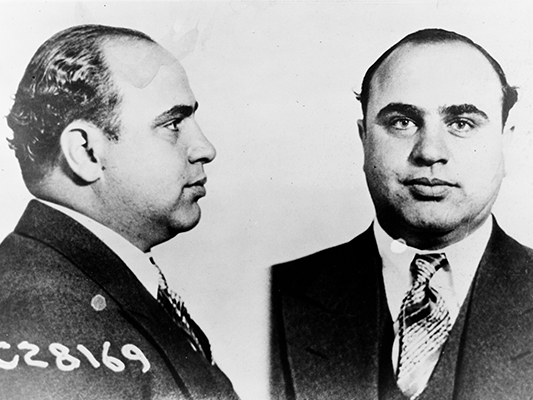Al Capone

Born: January 17, 1899, Brooklyn, New York
Died: January 25, 1947, Palm Island, Florida
Nicknames: Scarface, Snorky, the Big Guy, Big Al
Associations: Johnny Torrio, Jim Colosimo, Lucky Luciano, the Outfit, Bugs Moran
Alphonse Capone may be the most celebrated, or infamous, mobster in American history. His story has been told in dozens of fictionalized and true-to-life movies, television shows, books and other media. It’s an impressive collection for a man whose success and indeed whose life were relatively brief.
Growing up in New York City, Capone was active in the Five Points gang, a criminal enterprise of mostly younger Italian-Americans in Manhattan that also graduated such well-known mobsters as Charlie “Lucky” Luciano and Johnny Torrio. It was in New York that Capone suffered a facial wound in a fight at a brothel, earning him the nickname “Scarface.”
Torrio moved to Chicago in 1909 to work for syndicate boss “Big Jim” Colosimo, and in 1920 Torrio called upon Capone to join their growing enterprise in the Windy City. Colosimo operated hundreds of brothels and gambling rackets, but he reportedly refused to go into bootlegging, which, with the enactment of Prohibition in 1920, was a huge growth opportunity for organized crime groups.
Colosimo was shot to death the same year Capone came to Chicago. Although nobody was ever arrested for Colosimo’s murder, many believe Torrio ordered the hit, and that Capone was an accomplice in the killing.
Torrio inherited Colosimo’s organization and quickly capitalized on the illegal alcohol industry. His leadership was relatively short. In 1925, Torrio was shot and injured by a rival gang, and then he was sentenced to nine months in prison for operating an illegal distillery.
Torrio resigned as leader of the criminal organization that became known as the Outfit and, for three years, moved back to Italy. (He later returned to the United States and became something of an elder statesment among mobsters, helping to found the national Commission of the American Mafia in 1934.) With Torrio’s resignation, Capone took control of the Outfit.
From 1925 through 1929, Capone was the most-visible mobster in America. Capone worked with local media and friendly politicians to cultivate an image of a businessman concerned with the welfare of his fellow Chicagoans. But Capone’s tenure was also a period of rising rivalries with other Chicago gangsters, conflicts that frequently turned violent.
The escalating Mob violence in Chicago culminated with the St. Valentine’s Day Massacre on February 14, 1929. Seven members or associates of the Bugs Moran gang – rivals of Capone — were lined up against the wall of a garage by men posing as police and machine-gunned to death.
The brutality of the murders made headlines throughout the country. Although Capone was at his vacation house near Miami at the time of the massacre and never arrested for the crime, he was widely suspected of ordering the massacre. The St. Valentine’s Day Massacre happened just a month before Capone was arrested by federal agents for contempt of court for his failure to answer a federal subpoena, and he would ultimately be sentenced to six months on that charge.
But before he served his time on the contempt charge, Capone and his bodyguard were arrested in Philadelphia for carrying concealed weapons. Capone was sentenced to one year in Pennsylvania’s Eastern State Penitentiary. He served nine months, earning time off for good behavior, and was released in March 1930.
Capone’s troubles were just beginning. The U.S. Treasury’s Special Intelligence Unit had started compiling a tax evasion case against him. In contrast to the standard movie plot of tommy gun-firing G-Men bringing down the Mob, accountants and prosecutors assembled the most effective cases against people like Capone.
They did not have to prove Capone was orchestrating gambling, protection, prostitution and bootlegging rackets, simply that he wasn’t paying taxes on his income from those rackets. And it was clear that Capone had to have substantial income to support such a lavish lifestyle.
On October 18, 1931, Capone was convicted of tax evasion and sentenced to 11 years in federal prison. He served his time in the Cook County Jail and the Atlanta and Alcatraz federal prisons. The prison time was severe – a longer term than most tax evasion cases yielded — but that wasn’t Capone’s biggest problem.
Capone was infected with syphilis, a sexually transmitted disease, which in advanced cases was then incurable. By the time he left Alcatraz in 1939, the disease had profoundly affected his mental and physical health. Doctors reported that Capone had, in 1939, the cognitive processes of a 12-year-old child. He essentially retired with his family to his Florida mansion, where he died in 1947 at age 48.
Capone essentially retired from the Mob after his imprisonment in 1931, but the Outfit he had built up through bootlegging and other rackets went on without him under the leadership of Capone disciples such as Frank Nitti, Paul Ricca, Tony Accardo and Sam Giancana.




